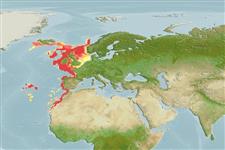Malacostraca |
Decapoda |
Cancridae
Environment: milieu / climate zone / djupintervall / distribution range
Ekologi
; djupintervall 37 - 750 m (Ref. 356). Temperate; 71°N - 22°N, 34°W - 7°E
Eastern Atlantic: from Morocco to Atlantic coast of Europe and southern coast of Iceland.
Length at first maturity / Size / Weight / Age
Könsmognad: Lm 10.5, range 13 - ? cm Max length : 22.1 cm CW hane/ej könsbestämd; (Ref. 2761); publicerad maxvikt: 1.9 kg (Ref. 2761)
Maximum carapace width: 20.0 cm (Ref. 435). Higher rate of female individuals in shallower strata, 200 to 400 m, and male individuals has a higher rate in deeper strata, 400 to 600 m. Landings of 10,000 per year (Ref. 2753). Unimodal size frequency distribution for both sexes (Ref. 2753, 2761). Occurs at depths from 37 to 700 m (Ref. 2761; 150 to 750 m in Ref. 356; 37 to 620 m in Ref. 435; and sublittoral to 700 m in Ref. 2753). Found on varied substrata (Ref. 2761). In general, species under the family Cancridae are omnivores, predators, or scavengers (Ref. 3477)
Exhibits spawning migration that results in ovigerous females occupying different territory from the rest of the population (Ref. 2753).
Fischer, W., G. Bianchi and W.B. Scott (eds.) 1981 True Crabs. 6: pag.var. In FAO species identification sheets for fishery purposes. Eastern Central Atlantic (fishing areas 34, 47; in part). Canada Funds-in-Trust. Ottawa, Department of Fisheries and Oceans Canada, by arrangement with the Food and AgriculturesOrganization of the United Nations, 1-7: pag.var. (Ref. 435)
IUCN Red List Status
(Ref. 130435: Version 2025-1)
CITES status (Ref. 108899)
Not Evaluated
Not Evaluated
Threat to humans
Human uses
Fiskeri: kommersiell
| FishSource | Sea Around Us
Verktyg
Ytterligare information
Trophic EcologyFood items (preys)
Födosammansättning
Födointag
Predatorer
PhysiologySyreförbrukning
Human RelatedStamps, coins, misc.
Internet-källor
Estimates based on models
Preferred temperature
(Ref.
115969): 6.8 - 14.1, mean 9.6 (based on 211 cells).
Resiliens
Hög, lägsta populationsfördubblingstid mindre än 15 månader (Fec=484,800).
Fishing Vulnerability
Low vulnerability (12 of 100).
Price category
Unknown.
